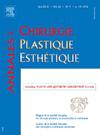利用 320 片计算机断层扫描术前研究腿部穿孔动脉系统,并为腿部软组织缺损患者设计穿孔皮瓣。
IF 0.5
4区 医学
Q4 SURGERY
引用次数: 0
摘要
目的:使用 320 片计算机断层扫描(CT 320)研究腿部穿孔器动脉系统,确定穿孔器皮瓣的椎动脉及其投影切点:方法:共对 24 名单侧腿部软组织缺损患者的 47 条腿进行了 320 片 CT 血管造影扫描(CTA 320)。所使用的方法可对源自胫、腓动脉的穿孔动脉、穿孔瓣的椎动脉及其投影切点进行研究。这些数据用于术前设计改良皮瓣。然后,将 CT 确认的皮瓣蒂动脉位置和长度与术中发现进行比较:结果:CTA 320 对 47 条腿的检查结果显示,共发现 217 条直径≥0.5 毫米的穿孔动脉;每条腿的平均动脉数量、平均长度和直径分别为 4.6±2.1、30.7±10.4 毫米和 1.16±0.27 毫米。源自胫前动脉的穿孔动脉主要分布在腿的近端和中段。来自胫后动脉和腓动脉的穿孔器则大量分布在腿的中段和远端三分之二处。正如 CT 所确定的那样,皮瓣蒂动脉的位置和长度及其投影切点与手术中观察到的一致:结论:CTA 320 是一种微创成像方法,可提供腿部穿孔动脉系统的高质量图像,并能确定穿孔皮瓣椎动脉的确切位置和投影切点。本文章由计算机程序翻译,如有差异,请以英文原文为准。
Using 320-slice computed tomography to preoperatively investigate the leg perforator arterial system and design a perforator flap for patients with a soft-tissue defect in the leg
Purpose
To investigate the leg perforator arterial system, identify the perforator flap's pedicle artery and its projected cutaneous point using a 320-slice computed tomography (CT 320) scanner.
Methods
A total of 24 patients with leg soft-tissue defects unilaterally underwent 320-slice CT angiography scanning (CTA 320) with 47 legs. The used method enabled investigation of the perforator arteries originating from the tibial, peroneal arteries, perforator flap's pedicle artery and its projected cutaneous point. These data were used to preoperatively design an improved flap. Then, the CT-confirmed location and length of the flap's pedicle artery were compared with intraoperative findings.
Results
Findings of the CTA 320 on 47 legs showed that 217 perforator arteries with diameters of ≥ 0.5 mm were detected; the average number of arteries per leg, their average length and diameter were 4.6 ± 2.1, 30.7 ± 10.4 mm and 1.16 ± 0.27 mm, respectively. The perforator arteries originating from the anterior tibial artery were mainly distributed in the proximal and middle thirds of the leg. Perforators from the posterior tibial and peroneal arteries were distributed abundantly in the middle and distal thirds of the leg. As identified in the CT, the location and length of the flap's pedicle artery and its projected cutaneous point were consistent with those observed during the surgery.
Conclusions
The CTA 320 is a minimally invasive imaging method that provides high-quality images of the leg perforator arterial system and can identify the exact location and projected cutaneous point of the perforator flap's pedicle artery.
Objectif
Investiguer le système artériel perforateur de la jambe, identifier l’artère pédiculée du lambeau perforateur et son point cutané projeté en utilisant un scanner à tomodensitométrie à 320 coupes (CT 320).
Méthodes
Un total de 24 patients présentant des défauts des tissus mous à la jambe ont subi une angiographie par tomodensitométrie à 320 coupes (CTA 320) unilatérale avec 47 jambes. La méthode utilisée a permis d’investiguer les artères perforatrices issues des artères tibiale et péronière, l’artère pédonculée du lambeau perforateur et son point cutané projeté. Ces données ont été utilisées pour concevoir préopératoirement un lambeau amélioré. Ensuite, l’emplacement et la longueur de l’artère pédiculée du lambeau confirmés par la CT ont été comparés aux résultats intraopératoires.
Résultats
Les résultats de la CTA 320 sur 47 jambes ont montré que 217 artères perforatrices d’un diamètre ≥ 0,5 mm ont été détectées ; le nombre moyen d’artères par jambe, leur longueur moyenne et leur diamètre étaient de 4,6 ± 2,1, 30,7 ± 10,4 mm et 1,16 ± 0,27 mm, respectivement. Les artères perforatrices issues de l’artère tibiale antérieure étaient principalement distribuées dans les tiers proximal et moyen de la jambe. Les perforateurs des artères tibiales postérieures et péronières étaient abondamment distribués dans les tiers moyen et distal de la jambe. Comme identifié à la CT, l’emplacement et la longueur de l’artère pédonculée du lambeau et son point cutané projeté étaient cohérents avec ceux observés lors de la chirurgie.
Conclusions
La CTA 320 est une méthode d’imagerie peu invasive qui fournit des images de haute qualité du système artériel perforateur de la jambe et peut identifier l’emplacement exact et le point cutané projeté de l’artère pédonculée du lambeau perforateur.
求助全文
通过发布文献求助,成功后即可免费获取论文全文。
去求助
来源期刊
CiteScore
1.00
自引率
0.00%
发文量
86
审稿时长
44 days
期刊介绍:
Qu''elle soit réparatrice après un traumatisme, pratiquée à la suite d''une malformation ou motivée par la gêne psychologique dans la vie du patient, la chirurgie plastique et esthétique touche toutes les parties du corps humain et concerne une large communauté de chirurgiens spécialisés.
Organe de la Société française de chirurgie plastique reconstructrice et esthétique, la revue publie 6 fois par an des éditoriaux, des mémoires originaux, des notes techniques, des faits cliniques, des actualités chirurgicales, des revues générales, des notes brèves, des lettres à la rédaction.
Sont également présentés des analyses d''articles et d''ouvrages, des comptes rendus de colloques, des informations professionnelles et un agenda des manifestations de la spécialité.

 求助内容:
求助内容: 应助结果提醒方式:
应助结果提醒方式:


